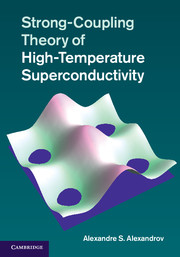Book contents
- Frontmatter
- Contents
- Preface
- 1 Coulomb and Fröhlich interactions
- 2 Small polarons
- 3 Inverse-coupling expansion technique
- 4 High-temperature superconductivity
- 5 Converting boson–fermion mixtures
- 6 Superconductivity from repulsion: Theoretical constraints
- 7 Theory and experiment: Confirmed predictions
- 8 Experiments explained: Normal state
- 9 Experiments explained: Superconducting state
- 10 Further predictions
- References
- Index
Preface
Published online by Cambridge University Press: 05 May 2013
- Frontmatter
- Contents
- Preface
- 1 Coulomb and Fröhlich interactions
- 2 Small polarons
- 3 Inverse-coupling expansion technique
- 4 High-temperature superconductivity
- 5 Converting boson–fermion mixtures
- 6 Superconductivity from repulsion: Theoretical constraints
- 7 Theory and experiment: Confirmed predictions
- 8 Experiments explained: Normal state
- 9 Experiments explained: Superconducting state
- 10 Further predictions
- References
- Index
Summary
The 1986 epoch-making discovery [1] by J. Georg Bednorz and K. Alex Müller of superconductivity in cuprates at incredibly high temperatures by the accepted standards is now recognised as one of the greatest scientific revolutions of the twentieth century. This discovery inspired a multitude of researchers worldwide to synthesise materials that are superconducting at temperatures more than six times higher than the earlier ones. High-temperature superconductivity has completely transformed the landscape of solid state science; it has led to the discovery of new classes of materials, of new states of matter, and of new concepts.
Strikingly, after more than 25 years of extensive experimental and theoretical efforts there is still little consensus on the origin of high-temperature superconductivity. The only consensus there is is that charge carriers are bound into pairs with an integer spin. Pairing of two fermionic particles has been evidenced in cuprate superconductors from the quantization of magnetic flux in units of the flux quantum [2]. Soon after that discovery the late Sir Nevill Mott answering his own question: ‘Is there an explanation?’ [Nature 327 (1987) 185] expressed the view that the Bose–Einstein condensation (BEC) of small bipolarons, predicted by us in 1981, could be the one. Several authors then contemplated BEC of real-space tightly-bound electron pairs, but with a purely electronic mechanism of pairing rather than with an electron–phonon interaction (EPI). However a number of other researchers criticised the bipolaron (or any real-space pairing) scenario as incompatible with some observed angle-resolved photoemission spectra (ARPES), with effective masses of carriers, and an unconventional symmetry of the superconducting order parameter in cuprates.
- Type
- Chapter
- Information
- Strong-Coupling Theory of High-Temperature Superconductivity , pp. ix - xiiPublisher: Cambridge University PressPrint publication year: 2013



